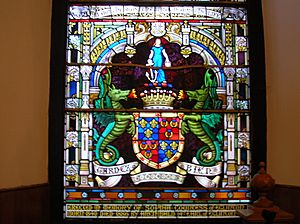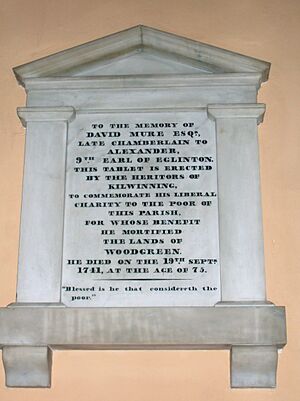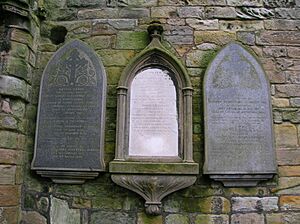Kilwinning Old Parish church facts for kids
The Kilwinning Old Parish church is a historic building in Kilwinning, North Ayrshire, Scotland. It stands on the very old site of Kilwinning Abbey. This church is a significant part of Kilwinning's history and has seen many changes over hundreds of years.
Contents
History of the Church
The First Church Building
Many people used to think that Kilwinning Abbey was completely destroyed during the Scottish Reformation, which was a big religious change in Scotland. However, there's not much proof for this idea. A famous mapmaker named Timothy Pont saw the abbey in the early 1600s and said that most of it was still standing! He described it as a "solid and great" building made of cut stone, with a "fair and stately" church, much like Glasgow Cathedral. He also mentioned a tall steeple, about 42 meters high, which he saw himself.
Pont even saw the original records from the abbey, which further suggests it wasn't totally destroyed. After the Reformation, the church no longer received money from its lands. This made it hard to keep up such a huge building, especially with damage from weather. So, local builders, including the Earls of Eglinton, started using stones from the old abbey for their own projects. A "new" parish church was then built within the abbey ruins, using some of the old stones. The first Protestant minister here was William Kilpatrick in 1587.
The Church You See Today
The current church building was finished in 1774. It was designed by John Swan and built by John Wright and John Garland. The Earl of Eglinton paid for the construction, which cost £546 at the time. You can still see an old stone in the church wall with the Eglinton family's coat of arms and the date 1593. This shows how old the site is!
Inside the Church
Inside, the church is quite interesting. A special part is the Eglinton Loft or Gallery. This was a private area just for the Earls of Eglinton and their guests. It even had its own entrance and a room with a fireplace, showing how important the Earls were.
The church has a beautiful organ, built in 1897. There's also a Memorial Screen dedicated in 1990. It remembers Colonel A. R. Cole-Hamilton, who died in 1915 during a battle called Gallipoli, along with his mother and wife. The screen shows the Cole-Hamilton family's coat of arms and the seal of the Abbot of Kilwinning Abbey.
You can also see some lovely stained glass windows. One is for Lady Sophia Montgomerie, who was the Countess of Eglinton. Another window, made by Stephen Adam, honors Rev Lee Ker, who was a minister here and wrote a detailed book about Kilwinning's churches. Other windows remember the Conn and Hendrie families, James Gaul, Alexander Stewart, Thomas Borland, and Rev Archibald Hunter.
To celebrate 800 years since the abbey was founded, members and friends of the church created an "800th Tapestry."
There's also a unique marble memorial stone for David Muir. He was a "Chamberlain" (a kind of manager) for the 9th Earl of Eglinton. David Muir was very generous and left his lands, called Woodgreen, to help the poor people of the parish.
The tower of the old abbey fell down in 1814. However, it was rebuilt, but a bit smaller, by Messrs Connell of Dalgarven. The architect for this rebuild was David Hamilton, who also designed the Eglinton Tournament Bridge. Around the same time in 1814, parts of the abbey church, like the choir and nave, were also repaired.
The Churchyard
The churchyard is where many people from Kilwinning's past are buried. This includes the Glasgow family from Montgreenan, David Muir (who we mentioned earlier), and several Earls of Eglinton and their families. Also buried here is Reverend Doctor James Steven, who was even mentioned by the famous Scottish poet Robert Burns in his poem 'The Calf'.
Images for kids
See also











